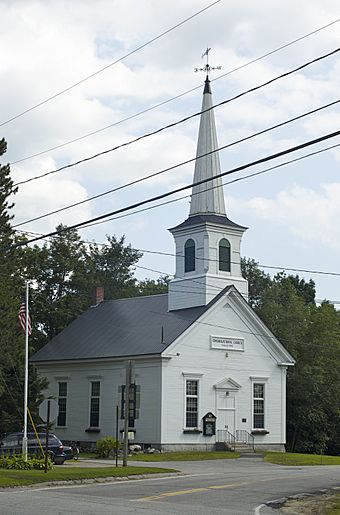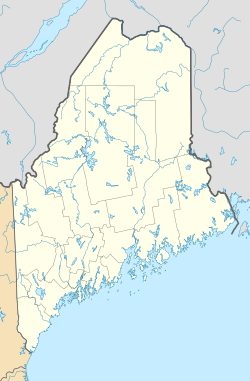Rumford Point Congregational Church facts for kids
Quick facts for kids |
|
|
Rumford Point Congregational Church
|
|
 |
|
| Location | ME 5 and US 2 jct., Rumford, Maine |
|---|---|
| Area | 0.5 acres (0.20 ha) |
| Built | 1865 |
| Architect | Jonathan Adams Bartlett |
| Architectural style | Greek Revival |
| NRHP reference No. | 85001259 |
| Added to NRHP | June 20, 1985 |
The Rumford Point Congregational Church is a special old church located in Rumford, Maine. You can find it where State Route 5 and U.S. Route 2 meet. It was built way back in 1865. This church is famous because it has amazing paintings on its walls and ceilings that trick your eyes! It's one of the few churches from the 1800s in Maine that still has these unique artworks. Because it's so important, it was added to the National Register of Historic Places in 1985.
What the Church Looks Like
The Rumford Point Congregational Church is in a historic area called Rumford Point. It's near a bridge that crosses the Androscoggin River. The church is made of wood and has one main floor.
It has a tall tower with a steeple and a weathervane on top. The front of the church has three sections. The main door is in the middle, with fancy columns and a triangular shape above it. The windows on the sides are tall. The bottom part of the tower is square, and the top part holds the church bell.
Amazing Eye-Trick Paintings
The most exciting part of this church is the special paintings inside. These paintings are called Trompe-l'œil (pronounced "tromp loy"). This is a French phrase that means "trick the eye."
The artist, Jonathan Adams Bartlett, painted the walls and ceilings to look like something they're not. For example, the ceiling looks like a big dome, even though it's flat. The walls are painted to make the choir area seem much larger than it really is. These paintings are very rare for churches from the 1800s in Maine. Some parts of the ceiling art have had a little water damage over the years.
See also



